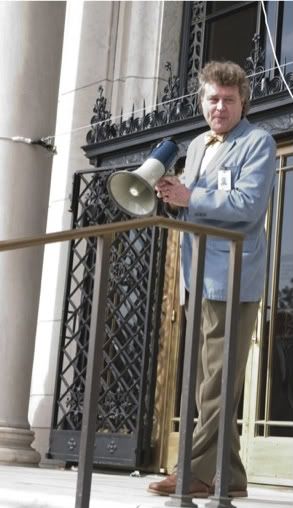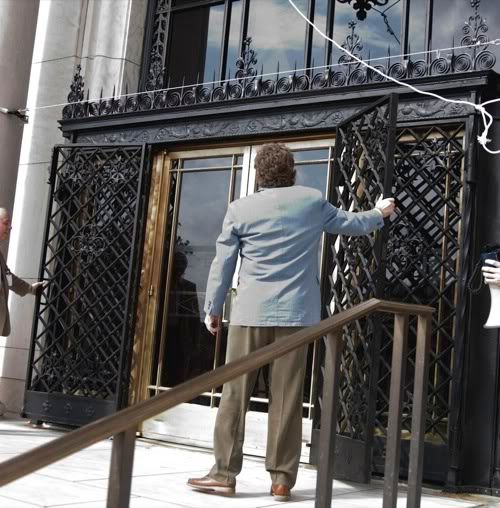

Above: Detroit Institute of Arts director Graham Beal locks the doors on the museum back in 2007 while the museum underwent its building addition. Hopefully, this closing won't ever have to happen for real!
"...GM has already notified about a dozen arts and cultural groups, including the Detroit Symphony Orchestra, Music Hall, the Michigan Opera Theatre and the Detroit Institute of Arts, not to expect any annual support from the company in 2009..." Mark Stryker/Free Press
"...There's only one truly major American art museum that's in trouble, the DIA. We'll probably know more about how much trouble at the end of the month, after AAMD's next meeting in San Diego. Word is that the DIA's condition will be a major behind-the-scenes topic..." Tyler Green/MANUPDATE: check out this story in the Times about museum bailouts:
Detroit Institute of Arts
The most striking change in institutional fortunes has been witnessed at the Detroit Institute of Arts, partly because the museum’s form and ambitions were so grand. Founded in 1888, and later housed in a majestic Beaux-Arts building two miles from the city’s downtown area, it was both a civic and cultural monument, “dedicated by the people of Detroit to the knowledge and enjoyment of art,” according to the words carved over its front door.
The collection is extraordinary, with renowned pictures by Jan van Eyck, Pieter Bruegel the Elder and Giovanni Bellini; one of the country’s premier troves of 19th-century American painting; and — the modernist pièce de résistance — Diego Rivera’s “Detroit Industry” murals, a proletarian fantasy paid for in 1934 by a heavy-hitting local patron, the industrialist Edsel Ford.
Comparable largess is all but nonexistent in Detroit today. Wealthy industrialists have faded from the scene. The Michigan state government gives almost no money to the institute, the city even less. In 1997 Detroit built the Museum of African-American History across the street from the institute, its spanking newness in sharp contrast to its older, crumbling neighbor.
Graham W. J. Beal, who arrived as director that year, has done much to stop the decline, largely — and this is where other museums should pay attention — through the use of material at hand. In 2007, to attract the city’s black majority and woo back white suburbanites, the museum unveiled a top-to-bottom rethinking of all the permanent galleries, with strategic shifts in emphasis.
The museum’s very fine African collection, developed by the curator Michael Kan, was placed upfront, near a main entrance, where it offers a cool yet absorbing introduction to the institute’s imperious interior. A gallery for African-American art, including Detroit artists, was added upstairs: it’s an important gesture, although something should have been done to make it look commanding rather than dutiful.Other parts of the collection have been reinstalled by interpretive theme, with wall texts reflecting the influence of a new art history that approaches objects as vehicles of social values. The texts are bland, but the idea is sound: this is the kind of context the Metropolitan Museum in New York should be offering in, among other places, its Greek and Roman galleries. Finally, child-friendly multimedia aids were added to deliver on the museum’s twin promise of knowledge and pleasure.
Pure-art hard-liners will spurn all of this. Accessibility, they will say, means stripping the museum of the lofty mystique that is its strength. And giving prominence to what was once called ethnic art means perpetuating old cultural imbalances yet in reverse, in the interest of political correctness, the thinking goes.
I disagree. I’d be glad if the museum added even more interpretive stuff but made it sharper and more challenging. If this causes problems, it can always be changed, but what’s the problem with causing problems? African art upfront? There’s no art I’d rather see anywhere, so why not there? As for political correctness, I’m over the whole idea, especially when the expression is used to demean sincere belief.
Whatever its shortcomings, the reinstallation proves that a major museum can recharge itself from within, from its own holdings. And this kind of recharging could well become the only viable route for museums. That said, it is no guarantee of security. Mr. Beal will soon announce yet another rethought version of the Detroit Institute: a “shrunken” museum of radically reduced resources in a city in financial free fall.../// NY Timesphotos: tryharder




No comments:
Post a Comment